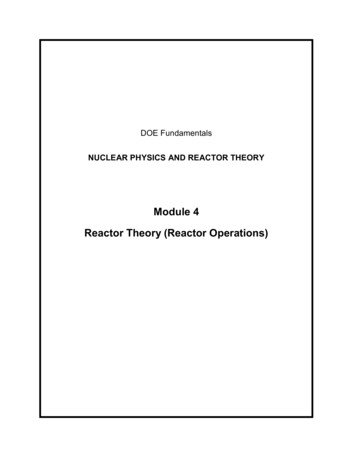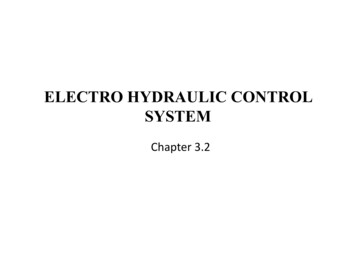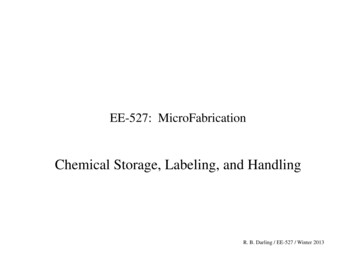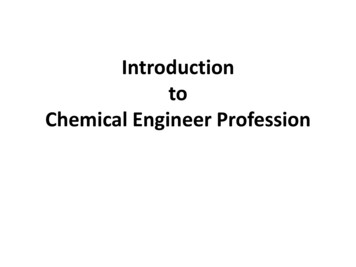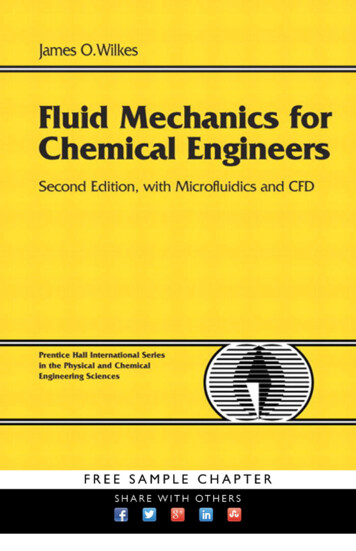
Transcription
An-Najah National UniversityDepartment of Chemical Engineering(Nablus/Palestine)Chemical Reactor Engineering Lab, 64428Instructor:Dr. ِAmer EL-HamouzEng. Maha FuqhaJanuary, 20111Prepared by : Dr. Amer El Hamouz , eng. Maha Fuqha
An-Najah National UniversityDepartment of Chemical EngineeringChemical Reactor Engineering Lab, 64428.Second term 2011Prerequisites: Chemical Reaction Engineering, Numerical Analysis for ChemicalEngineersText Book: Prepared Lab ManualReferences: 1- Elements of Chemical Reaction Engineering, Fourth edition, 2004,ISBN 0-13-253220-4H.Scott Fogler2- Chemical Reaction Engineering, second edition, 1999,ISBN 0 471-53019-0O. LevenspielInstructors: Amer M. EL-Hamouz, Associate Professor of Chemical EngineeringEngineer Maha Fuqha, Teaching AssistantIntroduction: This lab is one of the most important labs in the chemical engineeringstudy. In this lab, student will perform experiments to support their theoretical study ofBatch, CSTR and PFR reactors.Objectives:1- To familiarize students with main type of chemical reactors.2- To analyze the experimental data to obtain the reaction rate expression (reactionorder and specific reaction rate constant).3- Compare results obtained using different concentration measurement techniques.4- Compare the conversion of reactants during a specification reaction in varioustypes of reactor.5- Observe batch mixing under different operating conditions.OutlinePart A: Manual measurement of species concentration. Safety in Reaction lab. Homogeneous Batch Reactor Neutralization of Aqueous Solution Of Acetic Acid Mixing Behavior under Various Operating Conditions Scale up rules in the mixing tank. Effect of solution viscosity on mixing behavior in stirred tankreactors Mixing degree Measurements using spectrophotometer.2Prepared by : Dr. Amer El Hamouz , eng. Maha Fuqha
Plug flow reactorPart B: Chemical Reactor trainer Batch Reactor, Adiabatic ReactionBatch Reactor, Isothermal ReactionContinuous Stirrer Tank ReactorTubular Flow ReactorStirred Tanks in SeriesComments ALL STUDENTS ARE REQUESTED TO ATTEND ALL EXPERIMENTS. One formal repot should be submitted by each group. Final exam will be written examGrading :QuizzesperformanceReportsFinal Exam5%10%35%50%3Prepared by : Dr. Amer El Hamouz , eng. Maha Fuqha
An-Najah National UniversityDepartment of Chemical EngineeringChemical Reactor Engineering Lab, 64428.Second term 2011Instructions for Preparing Laboratory ReportsThe report must be prepared according to the following outline.1. Title PageThe Title page should be separate from the rest of the report. It should contain:a. The title of the experiment.b. The number of course.c. The names of the writer and his co-worker(s), their ID numbers, and group number.d. Name of the instructor to whom the report is submittede. The date when the experiment was runf. The date of submission of reportA sample title page is shown on page xv, which can be used when submitting reports.2. AbstractThe abstract should be informative, and should be written in about three to five sentences.It should cover all phases of the investigation. It must include the following:a. An introductory statement about the subject matterb. Brief description of what was done and how it was done.c. Selected results (numerical values, if available).d. Brief assessment of the results e.g. some percentage errors inExperimental results in comparison with theoretical values.While writing the abstract, no reference should be made to graphs, tables or equationsinside the report.3. IntroductionThis section should include few sentences discussing the physical and/or chemicalprinciples involved in the experiment. The importance and relevance of the experiment toreal applications may also be stated.4. Theoretical BackgroundThis section should include the theory behind the experiment. It should also contain allthose equations, which are used to acquire a certain result. Theoretical correlations, whichare used for comparison with experimental results, should also be included.5. ProcedureHere, you should briefly describe the actual step-by-step procedure you followed inrunning the experiment. It should be written in your own words, e.g. the needle valve wasmanipulated in order to adjust the liquid flow rate.4Prepared by : Dr. Amer El Hamouz , eng. Maha Fuqha
6. ResultsThe results should be presented in the form or Tables or graphs. The Table should containthe results obtained from experiments and from theoretical knowledge.Comparisons may also be presented in terms of percent deviation between experimentalvalues and theoretical predictions.7. Discussion of ResultsIn this section you should discuss your experimental results and observations. If theresults are obtained in terms of graphs, then interpret them also. Describe observed trendsand possible relationship between parameters e.g. how a change in one variable affectsanother. Also show how you make comparison with the values obtained theoretically anddiscuss the deviation of experimental results from theoretical values. The possible sourceof errors should also be mentioned.8. Conclusions and RecommendationsConclusions are the series of numbered sentences which answer the questions posed atthe beginning of each experiments. Conclusions should also include main results(numerical values) and the errors between the experimental and theoretical values. Whatyou have learned from the experiment should be mentioned as well.Recommendations are the proposals for future work, e.g. suggested changes inequipment, Study of new variables, or possible experiments in relative fields. Like theconclusions, the recommendations are usually listed by numbers, and each consists ofonly a sentence or two.9. Literature CitedHere, you should list the books, Journal’s articles, etc. used in writing your report andanalyzing the experiment. The reference should be completed (name of the book, author,volume, date of publication, pages, etc.). References should be arranged alphabetically byauthor’s names.10. NomenclatureThe symbols, which are used in the report, should be defined in the nomenclature inalphabetical order. The accompanying definitions must include proper units.AppendicesAll appendices and graphs should be attached at the end of the report.A1. Raw Data:It should contain the raw data (in the log sheet) collected during the experiment.A2. Analysis of Data and Sample Calculations:This shows how the collected experimental data are analyzed and transformed intoexperimental results by using the appropriate equations. Also, how the theoretical resultsare obtained using theoretical in terms of percentage error. Sample calculations shouldcontain each step, which is used to acquire certain results.5Prepared by : Dr. Amer El Hamouz , eng. Maha Fuqha
Organization and NeatnessThe students must organize their reports in accordance with the format described earlier.It is required/encouraged to use computer packages such as EXCEL, SIGMAPLOT,HARVARD, GRAPHICS or any other suitable engineering software to draw graphs. Theneatness will include how the student has organized his report, neat handwriting, accuracyin grammar and spelling, numbering pages, figures, tables and equations. Additionalpoints will be given to those students who use computers in preparing their reports.6Prepared by : Dr. Amer El Hamouz , eng. Maha Fuqha
An-Najah National UniversityDepartment of Chemical EngineeringChemical Reactor Engineering Lab, 64428.Second term 2008-2009Report Grading FormName of Student: ID #:Title of Report:Term: Date:SubjectMax MarkActual Mark1- Title Page2.2- Abstract203- Introduction54- Procedure55. Results156. Discussion of Results207. Conclusion and Recommendations88. Literature Cited59. Nomenclature210. Organization and Neatness4AppendixA1 Raw Data4A2 Data Analysis and Sample Calculation10Total100Signed:Comments:7Prepared by : Dr. Amer El Hamouz , eng. Maha Fuqha
Sample Cover PageKinetics Reaction LaboratoryHomogeneous Batch Reactor(Experiment no. 1, Performed on: February 20, 2008)Prepared by: Naser JaberGroup members: N. JaberA. Daqa M. Badran Submitted to: Eng. Maha FaqhaChemical Engineering DepartmentAn-Najah National UniversityFebruary 26, 20098Prepared by : Dr. Amer El Hamouz , eng. Maha Fuqha
III. Criteria for Evaluating Laboratory Reports andGrading PolicyTECHNICALFORMATAbstractDoes it stand alone?Is it understandable?Does it include a summary of the following- objective, introduction, Theory,Methods and Conclusions?ObjectiveIs the objective stated clearly and concisely?IntroductionDoes the introduction explain the relevance of the experiment to the field ofengineering?TheoryIs the theory explained?Are all the necessary formulas stated and variables defined?Experimental MethodsCan the experiment be reconstructed from the description given?Is there a diagram of the experimental set-up?ResultsIs presentation clear and concise? Are all the relevant Tables, Graphs,explanations included? Are the pertinent Sample calculations, References, etc.included in the Appendices?ConclusionAre the conclusions derived from the results of the experiment? Were thereany discrepancies from expected results? Is the objective of the experimentaccomplished?9Prepared by : Dr. Amer El Hamouz , eng. Maha Fuqha
WRITING QUALITYDoes the report follow the prescribed format?Is the language of the report easy to read? Is it precise? Does it conform to theconventional standards?10Prepared by : Dr. Amer El Hamouz , eng. Maha Fuqha
PART 1Experiment # 1HOMOGENEOUS BATCH REACTOR1.1 ObjectiveTo determine the order and value of the rate constant for the liquid reaction of causticsoda and ethyl acetate in a batch reactor:NaOH CH3COOC2H5 C2H5OH CH3COONa1.2 IntroductionA batch reactor may be described as a vessel in which chemicals are placed toreact. Batch reactors are normally used in small-scale laboratory set-ups to study thekinetics of chemical reactions.To determine the order and constant of a chemical reaction, the variation of aproperty of the reaction mixture is observed as the reaction progresses. Data collectedusually consist of changes in variables such as concentration of a component, totalvolume of the system or a physical property like electrical conductivity or refractiveindex.The data are then analyzed using pertinent equations to find desired kinetic parameters.1.3 TheoryFor any given reaction in a constant volume system, the rate of the reaction can berepresented by: rA kf (CA ) dCAdt(1.1)Where rA is the rate of disappearance of reactant A among the reacting species. Equation(1) can be rearranged to give: dC A kdtf (C A )(1.2)11Prepared by : Dr. Amer El Hamouz , eng. Maha Fuqha
Integrating equation (1.2) analytically yieldsCA f C A0tdC A k dt ktf (C A )0(1.3)By postulating various forms for f (CA) in equation (1.3) and correlating the resultingequation with the experimental data, the rate constant k, and order of the reaction can bedetermined.1.4 Procedure1.In the reactor, mix 1.0 liter of the 0.1M Caustic Soda (NaOH) solution with1.0 liter of the 0.1M ethyl acetate solution at an arbitrary time (t 0) at roomtemperature. Start the stirrer immediately at an intermediate speed to avoidsplashing.2.After a certain time interval, using a flask or graduated cylinder withdraw asample of known size (e.g., 25 ml) from the opening in the base of the reactor,and immediately quench this sample with an excess of 0.05M HydrochloricAcid (HCl) (e.g. 25 ml).3.Back titrate the quenched sample with 0.05M NaOH solution. The requiredamount of 0.05M NaOH should be recorded since this will enable you todetermine the concentration of NaOH in the reactor at the time you withdrewthe sample.4.Note that a drop or two of phenolphthalein should be added to the quenchedsample to detect the end point (i.e., stable new color) before you back titrate.Stirring the flask is also required during back titration.5.Repeat steps (2) and (3) every 5-10 minutes (and record the time for each newsample) until the amount of NaOH needed in the back titration is nearly equal tothe amount of the quenching acid.12Prepared by : Dr. Amer El Hamouz , eng. Maha Fuqha
Note 1Make sure to withdraw and analyze at least five samples of the reactor contents during thefirst 15 minutes of the reaction. To accomplish this it is recommended that you prepareknown quantities (25 ml) of the acid indifferent flasks before the start of the reaction.You can then withdraw the samples from the reactor quench, back titrate, etc.1.5 Report Requirement1. Calculate the number of moles of unreacted NaOH in each samplewithdrawn.2. Calculate the concentration of unreacted NaOH (mol/lit).3. Apply the integral method of analysis to determine the reaction order andrate constant of the reaction. This should involve assuming an expressionfor the reaction rate, substituting into equation 3, integrating, and thenplotting.4. Calculate the half-life of NaOH.5. Determine the fractional conversion of NaOH at the end of the reaction.6. Find both the order and rate constant of the reaction from literature andcompare between the theoretical and experimental values and give reasonsfor the deviations.Note 2You must give the exact reference i.e author, title and page number of the bookfrom which values were obtained.1.6 References1.Levenspiel, O., “Chemical Reaction Engineering”, 2nd ed., Wiley and sons, N.Y.,p.41 (1977).2.Smith J.M., “ Chemical Engineering Kinetics”, 3rd ed., McGraw-Hill Book Comp.N.Y., p.37 (1981).13Prepared by : Dr. Amer El Hamouz , eng. Maha Fuqha
HOMOGENEOUS BATCH REACTORRaw DataGroup Name ------------------------Temperature :---------------------- ºCTable 1.1Experimental DataSample #TimeSample Vol.Volume of HClUsed In QuenchingVolume NaOH UsedIn ---Date-----------------------14Prepared by : Dr. Amer El Hamouz , eng. Maha Fuqha
Experiment # 2NEUTRALIZATION OF AQUEOUS SOLUTION OF ACETIC ACID2.1 ObjectiveTo determine the order of the reaction and the value of combined mass transfer andkinetic rate constant.2.2 IntroductionDilute acetic acid (such as vinegar) with a pH of around 3.0 is a reasonablyeffective and inexpensive of the weak organic acids present in human body. This acidmay then be employed for simple laboratory simulation of the biochemical processesassociated with neutralization by commercial antacids used to relieve gastric distress. Theexperiment is based on the analysis of combined mass transfer and reaction kinetics.2.3 TheoryThe overall ionic reaction for the active acid neutralization system is:2H3O CO3(A) 3H2O CO2(2.1)(B)This expression is dependent upon the active ingredient.It is assumed that the instantaneous rate of the overall reaction, measured as the rate ofdisappearance of the hydronium ion is proportional to the instantaneous remainingsurface area of the tablets and the hydronium ion concentration, with the order for thelatter as yet unspecified. Thus1 dN An KaC AV dt(2.2)The area of a given tablet (disc) is the sum of its two faces plus its edges or15Prepared by : Dr. Amer El Hamouz , eng. Maha Fuqha
2 r2 2 rh . Assuming that the aspect ratio ( height / radius) of a given tablet remainsconstant throughout the dissolution process, the instantaneous surface area of a tablet is2 r2 (1 ). Eq. (2.2) then becomes, after assuming constant reaction volume (V).dCAn 2 Kmr 2 1 CAdt(2.3)It is necessary to relate CA and r in the above equation. From the stoichiometry of Eq.(2.1)dN AdN 2 Bdtdt(2.4)1 dN An Kmr 2 1 CAV dt(2.5)Eq. (2.3) then becomesWe further assume that the composition of an antacid tablet remain constant throughoutthe process. ThusNB mr 2 h X BMB NB mr 3 X BMB(2.6)Eq. (2.5) then becomesdr K 1 M BV n CAdt3 X B(2.7)From an overall material balanceC A C0 A 2 m X B 3 3R rM BV (2.8)Invoking the definition of PHpH log CA 16Prepared by : Dr. Amer El Hamouz , eng. Maha Fuqha
M BV30 r R C A C A 2 m X B 13(2.9)2.4 Equipment & Material A pH meter and electrode with a rapid response time of about 5-10 sections. Two buffer solutions (pH 1 and 7) for 2 point standardization of the pH meter. A magnetic stirrer, stirring bar and a timer. A set of vernier caliper to measure the dimensions of the antacids tablets. Standard laboratory supplies, such as beakers, graduated cylinders, and reagentbottles. Distilled white vinegar. Antacids tables as a neutralization agent.2.5 ProcedureFollowing is a step-by-step procedure:1. Remove protective tip from the pH electrode and rinse it well with distilledwater to remove any residue, which may have formed on the electrode tip.2. Perform 2 points’ standardization of the pH meter with the two buffersolutions in accordance with the procedure given in the manufacturer’sinstruction manual.3. Prepare a fresh acid solution by mixing 25 ml of distilled white vinegar and500 ml of distilled water in al 1 liter reagent bottle.4. Transfer 250 ml of this fresh acid solution from regent bottle to 500-mlbeaker, which is placed, on a magnetic stirrer.5. Place the beaker below the electrode assembly and lower the electrode tip intoacid solution. Ensure that the stirring bar does not hit to electrode tip duringthe operation.17Prepared by : Dr. Amer El Hamouz , eng. Maha Fuqha
6. Measure the thickness (h), the diameter (D) and the weight of the antacidtablets using vernier calipers and weight balance.7. Drop 3 to 5 tablets in the acid and start the timer. Adjust the stirring speed sothat a fair degree of homogeneity is achieved and the tablets are just barelylifted off of the bottom of the beaker.8. Record the pH values of solution at 30- second intervals for the first fiveminutes, at 1 minute intervals for the next 15 minutes and at 2 minuteintervals for the remainder of the run-until the tablets are completely dissolvedand the solution pH has off at a constant value (typically 40-50 minutes total).9. Repeat the above procedure for different type of antacid tablets.2.6 References1. Standers, S.A. and Sommerfeld, J.T. “A Laboratory Experiment on Combined MassTransfer and Kinetics”, Chem.Eng. Edu. Vol.22, No.2, Spring 1989,p. 86-91.2.7 NomenclatureaInterfacialCAConcentration of species ACBConcentration of species BDDiameter of the tabletKCombined mass transfer and kinetic rate constantMAMolecular weight of species AMBMolecular weight of species BmNumber of tabletsnOrder of reactionRRadius of the tablets18Prepared by : Dr. Amer El Hamouz , eng. Maha Fuqha
VVolume of the acetic acid solutionXBMass fraction of active ingredientα Aspect ratio Density of the tabletNEUTRALIZATION OF AQUEOUS SOLUTION OF ACETIC ACID1. Data AnalysisWrite the characteristics of antacid tabletsTable 2.1 Characteristics of antacid TabletsPropertyAntacid BrandActive (Alkaline) Ingredient TypicalMass of Tablets, gm.Mass of Active Ingredient, mgMass Fraction of Active, (XB) Ingredient.Mol. Wt. of Active Ingredient (MB)Typical Thickness of Tables(h), cmAspect Ratio ( h / R )Density of Tablets g / cm3No. of Tablets Used in the experiment (m)2. Determine the order of the reaction3. Determine the value of combined mass transfer and kinetic rate constant K.19Prepared by : Dr. Amer El Hamouz , eng. Maha Fuqha
2. Raw DataT, minpHT, minpHGroup --------------------20Prepared by : Dr. Amer El Hamouz , eng. Maha Fuqha
EXPERIMENT # 3Mixing Behavior under Various Operating Conditions3.1 Objective:To study the behavior of mixing under various operating.3.2 IntroductionMixing is applied to the processes used to reduce the degree of non-uniformity orgradient of a property in a system such as concentration, viscosity, temperature and soon.3.2.1 Type of MixingThere are many types of mixing:1.Single Phase Liquid Mixing.In this mixing two or more miscible liquid must be mixed to give a product ofa desired specification.2.Mixing of Immiscible LiquidsTwo immiscible liquids are stirred together, one phase become dispersed as tinydroplets in the second liquid which forms a continuous phase.3.Gas- Liquid MixingThe purpose of mixing here is to produce a high interfacial area by dispersing thegas phase in the form of bubbles into the liquid.4.Liquid-Solid MixingMechanical agitation may be used to suspend particles in a liquid in order topromote mass transfer or a chemical reaction.5.Gas-Liquid-Solid MixingLike slurry reactors, evaporative crystallization.21Prepared by : Dr. Amer El Hamouz , eng. Maha Fuqha
3.2.2 Rate and Time for MixingMixing time is the time required producing a mixture or a product of predeterminedquality, and the rate of mixing is the rate at which the mixing progresses towards the finalstate.For a single-phase liquid in a stirred tank to which a volume of tracer materials is added,the mixing time is measured from the instant the tracer is added to the time when thecontents of the vessel have reached the required degree contents of uniformity.The mixing time will depend upon the process and the following:1)2)3)4)System geometry.Impeller Diameter, D.Speed of rotation (revs/unit time) NProperties of liquids.t f (N, D, g, ρ, μ, system geometry)3.2.3 Mixing equipmentIn designing mixing equipment there are many factors that must be considered to obtain“desired process results”, among these factors are: Vessel size Vessel shapeVessels are typically cylindrical in shape, defined by H/T ratio:Where: H: vessel height,T: vessel diameter. The base of vessel may be flat, dished, or conical, or specially contoured,depend upon factors such as ease of emptying, or the need to suspend solids.BafflesBaffles are used to prevent cross vortexing, which is detrimental to mixing, particularly in lowviscosity systems. The baffles are mounted flush with the wall and these take the form of thinabout one-tenth of the tank diameter in width, and typically four qui-spaced baffles may be used. ImpellerThere are many types of impellers: propellers, turbines, paddles, anchors, helicalribbons and screws which are usually mounted on a central vertical shaft in acylindrical tank, and they are selected for a particular duty largely on the basis ofliquid viscosity.22Prepared by : Dr. Amer El Hamouz , eng. Maha Fuqha
Propellers, turbine and paddles are generally used relatively low viscosity systems andoperate at high rotational speeds. 3.4 Equipment and materialWaterdyeBeakers (2L).Stirrer3.5 ProcedureA. Effect of impeller positionB. Effect of speedC. Effect of aerationD. Effect of baffles1. Fill the beaker with water.2. Inject a dye at the top of a beaker.3. From time to time take sample and find it concentration by spectrophotometer.4. Operate the mixer under laminar flow.5. Observe how mixing is carried out and evaluate how long does it take to mix.6. Observe the aeration if happen or not.7. Repeat the same experiment but at higher speed that is in turbulent flow.8. Repeat the above experiments with different impeller position (1/2 and 1/3 fromthe bottom).9. Repeat the above experiments using baffles.23Prepared by : Dr. Amer El Hamouz , eng. Maha Fuqha
Mixing Behavior under Various OperatingConditionsGroup Name ------------------------Temperature :---------------------- ºCTable 3.1 Experimental DataSample #ImpellerheightSpeed(rev/min)ConcentrationMixing time(sec)Aerationheight(cm)Aeration height /impeller distance(cm/cm)1/3½24Prepared by : Dr. Amer El Hamouz , eng. Maha Fuqha
-------25Prepared by : Dr. Amer El Hamouz , eng. Maha Fuqha
1.2.3.4.5.6.Report on mixing time as a function of impeller speedPlot mixing time vs. time at low speed and high speed.Plot mixing time vs. time at different impeller position.Calculate the power consumption in each case.Compare between using baffles and not using it.Compare your results with theoretical data.26Prepared by : Dr. Amer El Hamouz , eng. Maha Fuqha
EXPERIMENT # 4Effect of fluid viscosity on mixing time4.1 Objective :To determine the effect of fluid viscosity on the mixing time and mixing quality4.2 Equipment and material CMC solution of different concentration.Beakers.Stirrerdye4.3 ProcedureFollowing is a step by step procedure:Adding non viscous to viscous:1- Prepare a 1L of viscous CMC solution of different concentration. Use aconcentrations of 0.2, 0.4 and 0.8%2- Prepare a 5 ml of dye solution of x % concentration for each concentration. Thissolution when fully mixed in the CMC concentration should give a finalconcentration of 300ppm.3- Fill the 2L beaker with the viscous fluid and use a low stirrer speed but adequatefor mixing (corresponds to the minimum turbulent Reynolds number value).4- Stop the mixer and gently add the dye solution at the top surface of the viscousfluid, switch on the stirrer and observe how the dye moves inside the batch.5- From time to time take sample and find it concentration by spectrophotometer.6- Draw a sketch for the movement of dye in the batch.7- Repeat steps 3 to 5 for other CMC solution.Adding viscous to non viscous:1- Fill a 2L beaker with 1L water and use a low stirrer speed but adequate formixing (corresponds to the minimum turbulent Reynolds number value)2- Prepare a 5 ml of CMC solution of different concentration (0.2, 0.4 and 0.8%).3- Add x of dye for each concentration that make the solution when fully mixedin water should give a final concentration of 300ppm.27Prepared by : Dr. Amer El Hamouz , eng. Maha Fuqha
4- Stop the mixer and gently add the dye solution at the top surface of the nonviscous fluid, switch on the stirrer and observe how the dye moves inside thebatch.5- From time to time take sample and find it concentration by spectrophotometer.6- Draw a sketch for the movement of dye in the batch.7- Repeat steps 3 to 5 for other CMC solution.28Prepared by : Dr. Amer El Hamouz , eng. Maha Fuqha
Effect of fluid viscosity on mixing timeGroup Name ------------------------Temperature :---------------------- ºCTable 4.1 Experimental oncentrationMixingtime0.1non Viscousto viscous0.30.60.1Viscous tonon -----------------1- Sketch mixing time vs time for all cases.2- How solution viscosity affect mixing time. Support your results with any existingcorrelation. ( use reference).29Prepared by : Dr. Amer El Hamouz , eng. Maha Fuqha
EXPERIMENT # 5Scale up of Stirred tank reactor5.1 Objective:To apply different scale up rules on scaling 200ml batch to 2000ml5.2 Equipment and material CMC solution of different concentration. Beakers. Stirrer dye5.3 ProcedureFollowing is a step by step procedure:1- prepare a 2% CMC solution.2- Fill the 200 ml beaker with the viscous fluid and use a low stirrer speed butadequate for mixing (corresponds to the minimum turbulent Reynolds numbervalue).3- Stop the mixer and gently add the dye solution at the top surface of the viscousfluid, switch on the stirrer and observe how the dye move inside the batch.4- From time to time take sample and find it concentration by spectrophotometer.5- Draw a sketch for the movement of dye in the batch.6- Use different scale up rules (equal Reynolds number, equal tip speed, and equalpower per unit volume) and record the mixing time for the 2000ml batch reactorand 5000 ml batch reactor.7- Repeat steps for another speed.8- Repeat steps for another viscous concentration 0.5%30Prepared by : Dr. Amer El Hamouz , eng. Maha Fuqha
Scale up of Stirred tank reactorGroup Name ------------------------Temperature :---------------------- ºCMixer speed --------------------------Volume ofreactor(ml)HDTable 5.1 Experimental --Date-----------------------1- Report on mixing time value at different scale (200 ml, 2000 ml and 5000 ml) with same speed.2- Using scale up procedure (Equale mixing time) what are the value of speed at each scale that givesame mixing time.31Prepared by : Dr. Amer El Hamouz , eng. Maha FuqhaMixingtime
EXPERIMENT # 6Plug Flow ReactorPlug flow ReactorObjectives:1- Study the effect of flow rate on the conversion of acid base reaction (Sodiumhydroxide and Ethyl acetate (EA)).2- Determine the conversion of the acid base reaction at different reactor length.3- Study the effect of recycle ratio on the final conversion of the acid base reaction.Procedure:123456-Prepare 2l of 0.1M sodium hydroxide, 0.1 EA and 1 liter 0.1M of HCl solutions.Set the peristaltic pump at flow rate of 30ml/minute.Fill the pump with EA solutionConnect the two solutions to peristaltic pumpSwitch on the pump at the desired flow rate.Every 1 minute take 10 ml sample and quench it with 10 ml of HCL. Samplesshould be taken from all sampling points.7- continue the experiment for 15 minutes8- report values of NaOH needed for titration, plot concentration of NaOH atdifferent location with time9- repeat experiment different flow rate, preferable double the previous flow rate.Experiment 21. Prepare 1 liter of 0.1M NaOH and 0.1M HCL2. Add phenolphtaline indicator to NaOH solution3. Pump the solution at low flow rate and take a sample of solution and add HCL ofknown volume and back titrate with NaOH4. Record the exit concentration with time and make an observation for colorchange.PART II32Prepared by : Dr. Amer El Hamouz , eng. Maha Fuqha
CHEMICAL REACTORS TRAINER1. Unit Layout and FunctionFig. 1.1 General View of Chemical Reactors TrainerFigure 1.1 shows the Chemical Reactors Trainer, which is used to compare theconversion of reactants during a saponification reaction in various types of reactor.Various reactor models, available as accessories, can be fitted to the base (3) of the unit.Two tanks (1), one behind the other, contain the liquid chemicals. The two reac
Department of Chemical Engineering Chemical Reactor Engineering Lab, 64428. Second term 2011 Prerequisites: Chemical Reaction Engineering, Numerical Analysis for Chemical Engineers Text Book: Prepared Lab Manual References: 1- Elements of Chemical Reaction Engineering, Fourth edition, 2004, ISBN 0-13-253220-4


